Take to the Hills
Spectacular scenery, miles of fishing to explore, hard-fighting wild brown trout, and a price tag that doesn't require a second mortgage - that is moorland trout fishing and here in the South West there is plenty to choose from. Head for the Dartmoor and Exmoor National Parks and you will find miles of sparkling streams, whether on the high open moors or in the deep wooded valleys that tumble down from the hills. The trout may not be very big, but there are plenty of them and, even after a day that has produced modest catches, there is something very special about wandering for hours along a wild river in unspoiled country.
But, as ever, there is a snag. Every year I meet fly fishermen who have ventured onto our moorland streams for the first time. They have enjoyed the experience and caught a fair number of wild trout but, they complain, hardly anything exceeded 15 centimetres - that's six inches in old money. Yet they have been fishing water where I know that the regulars have been taking plenty of browns from 20 centimetres up to 30 centimetres or more. So where are they going wrong and what can they do to improve their performance?
Many newcomers immediately turn to the fly pattern as the cause of their lack of success but the fly is rarely the problem. On the moors, virtually any suitable pattern will take fish, provided you fish it in the right place, at the right time, in the right way - and, above all, make sure that you have not scared every trout within reach before you even make the first cast. So here are some tips to help you make contact with the better-than-average trout that can seem to be so elusive.
Traditionally, many anglers fished the moors with three wet flies which were cast across the river and allowed to swing round on the current, but the Dartmoor and Exmoor streams are often too narrow for this method, so you are more likely to be successful when casting upstream with a dry fly, nymph or wet fly. As the trout will be facing upstream in the lively current, you have already gone a long way towards avoiding detection by approaching the fish from behind, and wearing drab clothes and keeping off the skyline will add to your chances of success.
Newcomers waste far too much time fishing unproductive water, so here are two places to avoid like the plague. Firstly those deep still pools where you can see the trout swimming around in the depths, but they can also see you and your chances of catching them are virtually zero. And secondly there are the shallow riffles, which are easy to fish but rarely hold anything worth catching. Look out for broken water of medium pace and medium depth, with plenty of cover within easy reach. On the open moors, cover usually means boulders and the pockets and runs on a boulder-strewn stretch can be very productive. And keep on the move. Moorland trout usually come in the first cast or two, so don't waste time fishing a spot that is producing nothing. I expect to fish at least a mile of river in a three-hour session.
To get the best out of moorland fly fishing you need to master the techniques of both the dry fly and the upstream wet fly or nymph - and there are times when a combination of the two is very effective. For dry fly fishing you need a good floater like a Humpy, Elk Hair Caddis or well-hackled Adams, while for wet flies and nymphs you need look no further than traditional patterns like Pheasant Tail, Half Stone, Blue Upright, Red Palmer and Hare's Ear Nymph. These flies should be tied mainly on size 16 and 14 hooks, with a few on 18 and 12 hooks. For wet fly fishing, two flies a couple of feet apart are enough, and it is worth trying a bright floater on the dropper and a drab nymph on the point, the theory being that the dropper catches the attention of the trout and the nymph fools it.
Whether wet or dry fly fishing, work slowly upstream, making a cast or two into every spot that looks likely to hold a trout, and paying particular attention to anywhere you see a fish rise. As the flies drop back towards you, always keep in touch by lifting the rod, so that when a fish takes you only need tighten to set the hook.
Upstream fishing with a dry or wet fly is best when the trout are feeding near the surface but there are times, especially early in the season, when they are almost glued to the bottom. At such times you need a fly that really bumps along the bottom and then a bead head comes into its own. A size 14 Hare's Ear or Pheasant Tail Nymph with a copper or gold bead at the head will often take trout when nothing else will, and your chances will be enhanced by an indicator on the leader to help you spot the takes. I once thought that I could spot any take without such aids but I have long since realised how many fish are missed without an indicator.
If you are planning your first outing for moorland trout, timing is vital to give you a good chance of early success. Eager to get started, many make that first attempt in March or April when the season opens, but they hardly see a fish and don't bother to try again. Even the local experts can struggle in the first few weeks so be patient and wait until late May or June. During this period, the trout normally feed all day and the tough times when the rivers become very low and clear should still be in the future.
There are always, of course, exceptions to any rule, as a day last summer was to prove. It was mid August, when the rivers are often sluggish and the trout very dour, but heavy rains had brought the Dartmoor streams into spate. The bigger rivers were still high and coloured but the tiny Cherrybrook was dropping fast and had cleared to the colour of tea. If the fish were feeding, it would be difficult to fail, so I walked downstream a mile from Upper Cherrybrook Bridge, tied a 12 Red Palmer on the dropper and a 12 Dunkeld on the point, and fished back up to the bridge through the middle of the day. The trout were immediately attracted to the two bright flies and nearly 50 trout up to 28 cm were caught, with fish on both dropper and point on two occasions. Some mediocre outings on Cherrybrook in the past few years had made me wonder if stocks had declined, but on a day when conditions were just about perfect, the fishing was as good as it ever was.
Dartmoor and Exmoor are ideal for really stretching your legs while you are fishing and the following few examples are typical of what the energetic angler can enjoy. On a fine day it is well worth fishing up the East Dart from Postbridge, with some of the best fishing in a lovely series of small pools about a mile above the bridge. A couple of miles fishing will take you almost to Sandy Hole Pass and then you can walk directly back to your car over Broad Down, with magnificent views to the south. Another favourite is to park at Watersmeet on the East Lyn and fish up to Rockford, ideally on a sunny day in late May when the Black Gnats are swarming over the river. Some of the large pools will be full of trout holding just below the surface and rising to anything that looks edible, but watch out for the smaller and less obvious pockets that are often more productive.
My local river is the Teign where the stretch from Fingle Bridge up to Dogmarsh Bridge is just about right for a three-hour session. The middle part of this piece of water below Sharp Tor tumbles down through a series of rocky pools that offer some of the best trout fishing on the upper Teign.

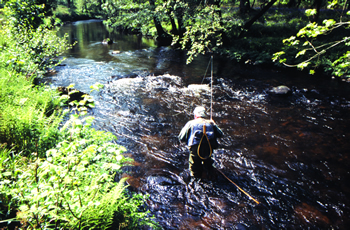
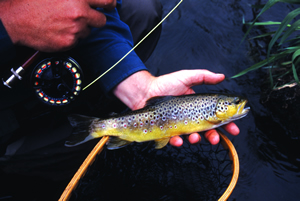 Taking advantage of advances in tackle is key to success, and developments in rods, lines, leaders and flies have all contributed to making it possible to go out with every expectation of success on a bright summer day. Terminal tackle took a great leap forward with the introduction of ultra-fine nylon for the point of your leader, light-weight rods with real power have become the norm as a result of carbon fibre, tiny nymphs sink quickly thanks to bead heads, and breathable waders make it possible to fish though the day without succumbing to heat stroke.
Taking advantage of advances in tackle is key to success, and developments in rods, lines, leaders and flies have all contributed to making it possible to go out with every expectation of success on a bright summer day. Terminal tackle took a great leap forward with the introduction of ultra-fine nylon for the point of your leader, light-weight rods with real power have become the norm as a result of carbon fibre, tiny nymphs sink quickly thanks to bead heads, and breathable waders make it possible to fish though the day without succumbing to heat stroke. Not so long ago, my river fishing was restricted to Saturday afternoons, having worked ‘up country’ from Monday to Friday. Those few precious hours were enough to completely de-stress me as everything in my head, except the job in hand, melted away. This is stress busting at its best and should really be available on the NHS.
Not so long ago, my river fishing was restricted to Saturday afternoons, having worked ‘up country’ from Monday to Friday. Those few precious hours were enough to completely de-stress me as everything in my head, except the job in hand, melted away. This is stress busting at its best and should really be available on the NHS.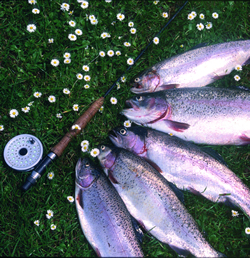 When the editor of Get Hooked asked me to come up with a dozen trout flies for all waters – both rivers and lakes – my reaction was something between incredulity and panic. A quick look at a couple of my fly boxes revealed dozen of patterns and I am sure that I could have produced a good reason for including every one of them. But a closer look revealed that a much smaller number showed the wear and tear of frequent use, while perhaps the majority were still in a relatively pristine state. So, perhaps the range of flies that catch most of my trout is rather narrower than the contents of the fly boxes would at first suggest.
When the editor of Get Hooked asked me to come up with a dozen trout flies for all waters – both rivers and lakes – my reaction was something between incredulity and panic. A quick look at a couple of my fly boxes revealed dozen of patterns and I am sure that I could have produced a good reason for including every one of them. But a closer look revealed that a much smaller number showed the wear and tear of frequent use, while perhaps the majority were still in a relatively pristine state. So, perhaps the range of flies that catch most of my trout is rather narrower than the contents of the fly boxes would at first suggest.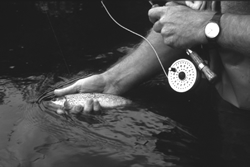 For the fly fisher who seeks nothing more than a sparkling stream to explore for a trout the South West is a wonderful place. Whether the moorland rivers of Dartmoor and Exmoor or the silky chalk streams of Wessex, this is a region with endless opportunities and challenges, not only for the dedicated river angler but also for many reservoir fishers who head south west for a different experience.
For the fly fisher who seeks nothing more than a sparkling stream to explore for a trout the South West is a wonderful place. Whether the moorland rivers of Dartmoor and Exmoor or the silky chalk streams of Wessex, this is a region with endless opportunities and challenges, not only for the dedicated river angler but also for many reservoir fishers who head south west for a different experience.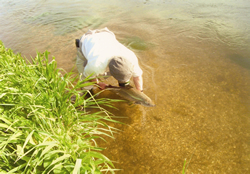 The southern, lowland chalk streams of Wessex have a rich bio-diversity that has, for millennia, supported thriving populations of fish, flora, birds and invertebrates. Foremost among these is the famous River Hampshire Avon. Rising from the chalk aquifer of Salisbury Plain as the East and West Avon, it heads south for Salisbury where it is joined by the Rivers Bourne, Wylie, Nadder and Ebble, each offering individual characteristics and angling opportunities whilst hosting the catchment’s spawning salmon. These revered centres of trout fishing, and on the Nadder coarse angling as well, set the standard for the main river that runs from Britford through Hampshire to the sea at Christchurch in Dorset, briefly meeting with the River Stour, from the west.
The southern, lowland chalk streams of Wessex have a rich bio-diversity that has, for millennia, supported thriving populations of fish, flora, birds and invertebrates. Foremost among these is the famous River Hampshire Avon. Rising from the chalk aquifer of Salisbury Plain as the East and West Avon, it heads south for Salisbury where it is joined by the Rivers Bourne, Wylie, Nadder and Ebble, each offering individual characteristics and angling opportunities whilst hosting the catchment’s spawning salmon. These revered centres of trout fishing, and on the Nadder coarse angling as well, set the standard for the main river that runs from Britford through Hampshire to the sea at Christchurch in Dorset, briefly meeting with the River Stour, from the west.